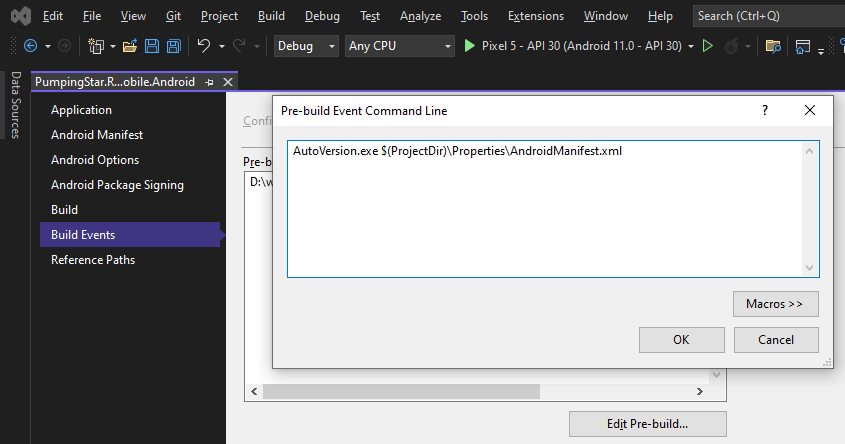自动增加 Android App 的版本号
一般的 C# 应用程序中都有一个 AssemblyInfo.cs 文件,其中的 AssemblyVersion attribute 就可以用来设置该应用程序的版本号。譬如,
1 | [assembly: AssemblyVersion("1.0.*")] |
这样设置的 AssemblyVersion attribute,其版本号中的构建编号(Build Number),在每次编译(Build)该应用程序时,就会自动加1。这样,版本号中的主、次版本号由手动设置,而构建编号由编译程序(MSBuild)自动管理,省去了很多麻烦。
但 Android App 的版本号却无法使用这种方式,因为 Android App 的版本号存在于 AndroidManifest.xml 中:
1 2 3 4 5 6 7 8 9 10 11 | <?xml version="1.0" encoding="utf-8"?><manifest xmlns:android="http://schemas.android.com/apk/res/android" <strong>android:versionCode="3" android:versionName="1.0"</strong> package="mypackage" android:installLocation="auto"> <uses-sdk android:minSdkVersion="21" android:targetSdkVersion="31" /> <application android:label="MyPackage.Android" android:theme="@style/MainTheme" android:allowBackup="false"> </application></manifest> |
在这个 AndroidManifest.xml 文件中,App 的版本号(versionName)是“1.0”,构建编号(versionCode)是“3”。我们希望能够像 C# 程序一样,由编译程序自动管理构建编号。但似乎还没有这样实现自动管理的编译程序,所以只能自己动手实现类似的功能。
网上找到了一段C#代码,可以完成自动增加 versionCode 的功能:
1 2 3 4 5 6 7 8 9 10 11 12 13 14 15 16 17 18 19 20 21 22 23 24 25 26 27 28 29 30 31 32 33 34 35 36 37 38 39 40 41 42 | ////////////////////////////////////////////////////////// AutoVersion// Increment the Android VersionCode automatically// Version// 1.0// Author// prowyh@hotmail.com// Date// 2022-11-22// Curtesy// 9to5answer.com/auto-increment-version-code-in-android-app////////////////////////////////////////////////////////using System.Text.RegularExpressions;namespace AutoVersion{ internal class Program { static void Main(string[] args) { string file = "AndroidManifest.xml"; if (args.Length > 0) { file = args[0]; } try { string text = File.ReadAllText(file); Regex regx = new(@"(?<A>android:versionCode="")(?<VER>\d+)(?<B>"")", RegexOptions.IgnoreCase); Match match = regx.Match(text); int verCode = int.Parse(match.Groups["VER"].Value) + 1; string ntext = regx.Replace(text, "${A}" + verCode + "${B}", 1); File.WriteAllText(file, ntext); } catch (Exception exp) { using StreamWriter sw = new("AutoVersion.log"); sw.Write(exp.Message); } } }} |
将此代码编译为 AutoVersion.exe,将其包括在 Visual Studio 的 pre-build 事件所执行的命令行中(如下图),即可。

这样,每次点击 “Build Solution” 进行编译时,都会先执行 AutoVersion.exe,完成对 AndroidManifest.xml 中 versionCode 的自动增1 操作。
下面是 AutoVersion.cs 的 PowerShell 版本:
1 2 3 4 5 6 7 8 9 10 11 12 13 14 15 16 17 18 | <# .SYNOPSIS AutoVersion.ps1 .DESCRIPTION PowerShell script for automatically incrementing the Android VersionCode. .VERSION 1.0 .AUTHOR prowyh@hotmail.com .DATE 2022-11-22#>$content = Get-Content AndroidManifest.xml[regex]$rx = "(?<A>android:versionCode="")(?<VER>\d+)(?<B>"")"$m = $rx.Matches($content)$nv = $([System.Int32]$m[0].Groups["VER"].Value + 1)$nvCode = $m[0].Groups["A"].Value, $nv, $m[0].Groups["B"].Value -join ""$content -replace "android:versionCode=""(\d+)""", $nvCode | Out-File -FilePath AndroidManifest.xml |
2022-11-24 更新
对于 .NET MAUI 项目,Android.Manifest.xml 与 Xamarin.Forms 的一样,但位置变了。可以通过 mauiApp.csproj 项目文件进行设置,如下所示:
1 2 3 4 5 6 7 8 | <Project Sdk="Microsoft.NET.Sdk">...... <Target Name="PreBuild" BeforeTargets="PreBuildEvent" Condition="$([MSBuild]::GetTargetPlatformIdentifier('$(TargetFramework)')) == 'android'"> <Exec Command="D:\AutoVersion\AutoVersion.exe $(ProjectDir)\Platforms\Android\AndroidManifest.xml" /> </Target></Project> |
需要注意的是,因为一个MAUI解决方案中包含了若干项目,在编译(Build)时,每个项目都要 Build 一遍,导致 AutoVersion 执行多次。解决的办法是使用条件(Condition) attribute 将 AutoVersion 的执行限制在编译 Android 项目时。





【推荐】国内首个AI IDE,深度理解中文开发场景,立即下载体验Trae
【推荐】编程新体验,更懂你的AI,立即体验豆包MarsCode编程助手
【推荐】抖音旗下AI助手豆包,你的智能百科全书,全免费不限次数
【推荐】轻量又高性能的 SSH 工具 IShell:AI 加持,快人一步